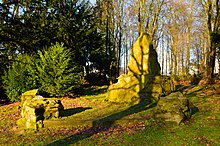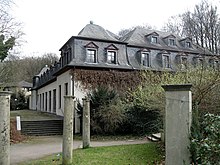Hohenstein (Witten)
The Hohenstein is part of the green belt of the Witten city center. It ends at the Berger monument on a more than 100 m high rock face, which is responsible for the name. Hohenstein is, however, also the name of a district of Witten-Mitte ( see also: criticism ).
meaning

The Hohenstein is a popular local recreation area for all ages. The generous open spaces leave space for all kinds of activities. There are also some simple leisure facilities such as a water playground and table tennis tables . In the immediate vicinity there are several game enclosures and a training bee center . Occasional open-air concerts and other events complete the offer.
Between 1913 and 1914, the Hohenstein parking garage was built in the Wilhelmine style . This defining building was converted into a seminar center with subsidies in 1994 and operated as such for ten years. After the seminar was closed in 2004, no other use was permitted due to the funding guidelines.
At the beginning of 2009, the building and the adjacent guest house were sold to private individuals by the city of Witten, and catering has been open again since May 2009. In August 2009, after a four-month renovation period, Witten's first near-natural kindergarten was opened on the lower floor and 22 guest rooms were opened on the upper two floors.
The Hohenstein multi-storey car park was connected to a slightly higher stone pavilion, popularly known as the Haarmann Temple, via a central line of sight. This line of sight typical of the time is now overgrown. The pavilion was built by his brother in honor of the former mayor of Witten, Gustav Haarmann .
The republican memorial in honor of the politicians Friedrich Ebert ( SPD ), Matthias Erzberger ( center ) and Walther Rathenau ( DDP ) nearby was unveiled in 1926 in front of 30,000 participants. The monument was badly damaged during the Nazi dictatorship . Original plans provided for this memorial to be erected in a workers' settlement on the outskirts of the city center. Nothing is known about the reasons why it was then built on the then nationally important excursion destination on the Hohenstein. After two restorations in 1985 and 2006, it is now open to the public again.
At the foot of the Hohenstein is the former hammer pond of an early industrial smithy . Today it is part of the recreation area and is used by the local ship model builders as a navigation channel. There is a small children's playground and a public miniature golf course near the dam .
history
Although located near the Ruhr , the district did not play a major role in Witten's life in earlier times. The rocky hill was not suitable for agriculture, which is why the area was previously used exclusively for logging. At the end of the 18th century, charcoal burners settled in the Hohenstein area and gradually cut aisles in the forest to extract wood. These aisles were not afforested and within a few years the forest was almost completely cleared. Of course, iron ore and coal seams also ran out here and were mined from the surface in the Middle Ages.
Its location a little away from the city of Witten, with a good connection to the train service at the time, made the government of the province of Westphalia aware of this area. In 1891 the government drafted the plan to build a large psychiatric clinic on the Hohenstein . The city council of Witten was against this plan and got ahead of it by simply buying the area on the grounds of wanting to create a city park . There was never such a thing in the city. The forest was reforested and large meadows were created at the same time. In 1902 the Berger memorial was erected on the Hohenstein .
On the initiative of Konrad Maria Krug , a natural theater was built on the Hohenstein in 1926 . The necessary area was cleared into the Hohenstein and a grandstand with 6000 seats and an access road were created next to the stage area . From 1926 to 1932 the Landesheimatspiele of the Province of Westphalia Witten-Hohenstein were staged there and the Hohenstein became the largest open-air theater in Germany.
See also: Hohenstein hydropower plant .
criticism
The district of the area as the district of Witten-Mitte is from today's perspective considered a purely administrative statistical construct. Neither is there name signs to "Hohenstein" or "Witten-Mitte, the district Hohenstein" pointed, nor is the term "Hohenstein" in some form commonly used in everyday language. Nevertheless: In the official demarcation of the city of Witten, “Hohenstein” is listed as Statistical District 19 of Witten-Mitte. Historically, the term “Hohenstein” appears primarily in the 1920s in connection with the so-called state home games of the province of Westphalia Witten-Hohenstein .
Residents
The statistical district had a total of 1353 inhabitants on December 31, 2018.
Web links
- Hohenstein park. City of Witten
Individual evidence
- ↑ Population in the statistical districts. (PDF; 30 kB) In: Witten.de. December 31, 2018, accessed March 25, 2020 .
Coordinates: 51 ° 26 ' N , 7 ° 21' E

